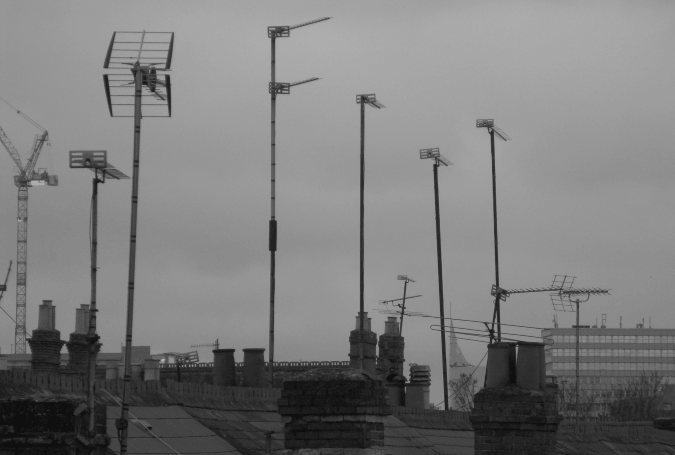It is a common request from Local Planning Authorities (LPAs) that developers investigate the possible impact of a new building development on existing terrestrial television signals in the surrounding area. Therefore, in this article Pager Power’s recommended step-by-step approach for assessing the effect of large buildings on television signals is outlined.
Figure 1 below shows television aerials over Reading’s skyline.
 Figure 1: Television aerials over Reading (UK) rooftops
Figure 1: Television aerials over Reading (UK) rooftops
Analysis Methodology- A Step-by-Step Approach
Pager Power recommends a systematic approach for the assessment of possible television interference issues associated with large buildings. The steps, in order, are presented below:
- Desk-Based Television Impact Assessment – includes modelling of any predicted impacts based on the calculated CIR to determine the locations most susceptible to television interference;
- Television Baseline Survey – includes actual television signal strength taken at key locations based on the results of the modelling;
- Television Written Scheme – includes a scheme for mitigating any interference experienced that is caused by the proposes building development;
- Post-Construction Survey – a follow up survey after the development has been built. This can be used to measure the change to the baseline television signal condition or to determine whether mitigation is required.
Assessments 1, 2 and 3 are interchangeable with respect to the order in which they are completed however, Pager Power recommends this order because:
- The Desk-Based Assessment informs Baseline Survey locations.
- The results of the Desk-Based Assessment and Baseline Survey provides the most accurate prediction of possible television interference issues.
- The Television Written Scheme is often requested by the Local Planning Authority (LPA) as a planning condition at the time when planning permission is granted. At this point in the development timeline, it is a good idea to know any possible interference issues to inform the Television Written Scheme.
Television Interference Mechanisms and Modelling
The quality of the image and sound on a television set is dependent on both the strength of the signal received directly from the transmitter (the Carrier signal) and the strength of the Interference signals from other sources. Interference mechanisms include reflecting and/or physically blocking the television signals between a transmitter and a receiving aerial.
Pager Power’s methodology for assessment of interference effects was developed based on evaluation of the predicted Carrier to Interference Ratio (CIR). To achieve good quality reception an aerial must receive a strong Carrier signal but weak Interference signals.
The CIR is evaluated by taking the ratio of the predicted signal strength (provided directly from the transmitter) to the predicted interference signal strength (reflections from the building).
Conclusions
Pager Power recommends implementing a systematic approach that can save time and money further down the project timeline. Of course, if you require a bespoke proposal with a combination of any of the above listed services we would be happy to discuss your project and your requirements. Call +44 (0) 1787 319001 or email info@pagerpower.com.
Image accreditations: “Reading rooftops” by Secret Pilgrim via Flickr / CC BY-SA 2.0 / Image cropped and resized from original.

